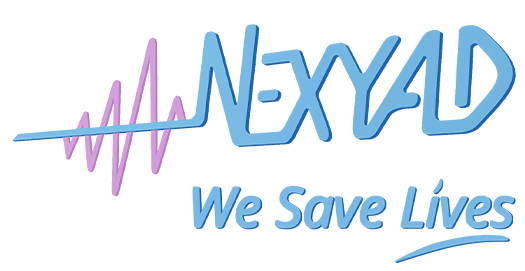ESTIMATION OF DRIVER’S EXPERTISE, OF RISK TAKEN CONSCIOUSLY BY THE DRIVER,
AND OF THE LACK OF ANTICIPATION AND MISUNDERSTANDING OF THE ROAD
By NEXYAD
Lire la version Française
I – INTRODUCTION
NEXYAD has been developing the smartphonte application SafetyNex which estimates the risk of driving in real time [1]. SafetyNex is both a driver assistance system (ADAS), which alerts the driver (vocal alert) before danger (When the risk increases too much), and a telematics system that records risk profiles and usage profiles.
Warning before the danger gives the driver time to slow down and avoid the accident. Road Safety studies show that SafetyNex can reduce the number of accidents by 20% [2]. This simple functionality is of interest of car insurers, fleet managers, and to car manufacturers.
SafetyNex also rewards the driver with cups (gold, silver, bronze) that can be transformed into money incentive (vouchers, etc.) so that the safe drivers stil have a daily interest to go on using SafetyNex. Indeed, tools that are not used over a period of time rarely have a real effect on the accidentology. SafetyNex is therefore distinguished from other products, on the one hand by its real time and driving assistance, but also for its « reward » side. SafetyNex informs the driver In real time when the risk exceeds a threshold of danger, than one can say that SafetyNex gives the risk in the hands of the driver first. The driver is in control of his/her risk.
Then SafetyNex distinguishes from all telematics products that ultimately provide information to the insurer or fleet manager, but not to the driver who feels rightly spied on.
Risk and usage profiles [3] are forwarded to managers who have an interest in minimizing risk and the number of accidents. This paper presents a simple way to interpret the risk profiles constructed by SafetyNex.
II – SafetyNex RISK PROFILES
SafetyNex estimates risk of driving at every instant.
Since SafetyNex also measures usages, it measures among other things the durations and the number of traveled kilometers.
One can then construct the curve Risk (t) which is the risk at each moment, and also the curve Risk (km) which is the risk at each point of the route.


Let’s consider one or the other of those curves, it is easy then to cut the risk into slots:

It is therefore possible to calculate the total duration spent [resp the total number of km carried out] with a risk
between 10% and 20%, for example (or between 50% and 60%). The graph of these durations [resp number of km] for each range of risk (0% -10%, 10% -20%, etc.), looks like :

It can be seen that this graph can be seperated into three parts:

. A very high bar of near zero risk
. A shape of « bell curve » comparable to a gaussian
. Rising at the very end towards high risks
NEXYAD has run over 3,500 testers since June 2016, and has been able to interpret the shapes of these curves.
III – INTERPRETATION OF SafetyNex RISK PROFILES : CONSENTED RISK, EXPERTISE OF DRIVING, LACK OF ANTICIPATION OF DRIVER
The large quasi-zero risk bar simply expresses the fact that overall the car is a safe mode of transportation.
The part that draws a bell curve has a more or less strong spread : we have noticed that experienced drivers have a narrow curve (repeatability of their driving style is high) while beginners have a huge spread (they can’t drive always the same way).
The centering of the bell curve (maximum likelihood) corresponds to the way in which the driver takes a controlled Risk : cautious beginners have a low maximum likelihood (they try to take as less risk as they can) while experienced drivers have a higher maximum likelihood : they know what risk level thay can cope with.
Finally, the values that go up to the right (tail of distribution of the curve in bell) correspond to the vocal alerts, that is to saycases where the driver has not fully understood that the risk is high. In other words, it is the lack of anticipation and misunderstanding of road.
IV – CONCLUSION
SafetyNex’s risk profiles make it possible to understand the kind of driver you have :
. Cautious / not cautious (maximum likelihood of the bell curve position)
. Experienced / beginner (spreading of the bell curve)
. Lack of anticipation / very good anticipation (queues of distribution of the curve in bell)
Fleet insurers and managers therefore have all the information that they need to help the driver.
For example, within the framework of prevention plans, offering training adapted to each type of risky driving.
We validated this information by driving 3,500 testers, including beginners, experienced drivers, and also pilots (who in take risks appearance, but in reality have a very safe driving). This allowed us to give these interpretations of SafetyNex’s risk profiles.
With the deployment of SafetyNex to reduce the number of accidents, professionals structurally gain margin, and can use this margin to analyze profiles, segment them, and find the segments where it may be interesting to develop UBI (Usage Based Insurance) and real time pricing fleet.
This multi-functionality of SafetyNex makes it a unique and effective tool for managing driving risks.
V – REFERENCES
[1] : THE ULTIMATE SOLUTION FOR INSURANCE COMPANIES THAT NEED ONBOARD RISK ASSESSMENT : SafetyNex
[2] : SMARTPHONE APP SafetyNex COULD REDUCE ACCIDENT RATE BY 20%
[3] : EXAMPLE OF SafetyNex RISK PROFILES










